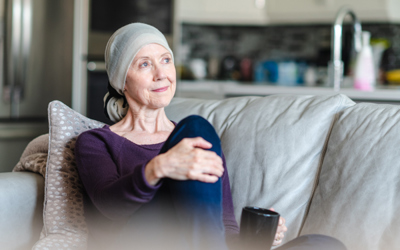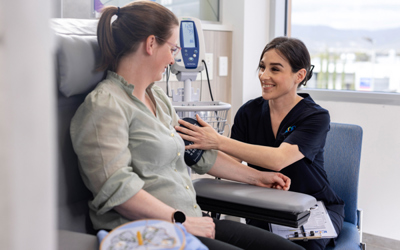What are the treatment options for anal cancer?
The primary treatment options for anal cancer include surgery, radiotherapy and chemotherapy. The type of treatment you receive will depend on a number of different considerations, such as the type of anal cancer you have, its stage, your overall health and your treatment preferences. This page aims to give you a comprehensive overview of how anal cancer treatment works.
Surgery for anal cancer
Surgery may be recommended for people with anal cancer who have small tumours which measure less than 2 centimetres across and do not involve the sphincter muscle (the muscle at the opening of the anus which gives you control of your bowel movements). The type of surgery you receive will depend on the type of anal cancer you have, its size and where it is located.
Types of surgeries include:
-
Local resection
A local resection may be used to treat early and small tumours. The procedure involves removing the tumours from the anus and aims to avoid causing any damage to the sphincter muscle.
-
Abdominal-perineal (AP) resection
To treat more advanced stages of anal cancer, or anal cancer that has returned, an abdominal resection may be performed. This involves an incision which is made to the abdomen to remove the anus, rectum, part of the colon and, in some cases, the surrounding lymph nodes. As part of this procedure, the end of the remaining intestine is surgically attached to an opening in the abdomen, called a stoma. Through the stoma, a disposable bag (called a colostomy bag) will be attached to collect waste from your body.
Radiotherapy for anal cancer
Anal cancer patients who are suitable for radiotherapy treatment will usually receive external beam radiotherapy, and in some cases, internal radiotherapy to increase the effectiveness of other treatments. Radiotherapy can be given as a definite treatment, usually together with chemotherapy, before surgery or as a supplementary treatment after surgery.
Due to the location of anal cancer, radiotherapy to this area of the body may cause temporary or permanent infertility in both men and women.
External beam radiotherapy
External beam radiotherapy (EBRT) is used to treat anal cancer by delivering highly targeted radiotherapy beams to cancerous tumours. The most common types of EBRT techniques which are used to treat anal cancer include:
Internal radiotherapy
Internal radiotherapy is also known as brachytherapy. This type of radiotherapy is a less common method to treat anal cancer, however it may be used together with external beam radiation to more effectively treat your cancer.
Chemotherapy for anal cancer
Chemotherapy uses a range of drugs to kill and slow the growth of anal cancer cells. Anal cancer patients may receive chemotherapy alone or alongside radiotherapy (a treatment method known as chemoradiation). While chemotherapy can be delivered in a number of different ways, it is most commonly given intravenously for anal cancer. When you are treated with chemoradiation, your radiotherapy will begin on the same day as your first chemotherapy treatment.
Learn more about chemotherapy and how it is delivered.
Chemotherapy treatment for anal cancer takes place over several sessions, known as a cycle. Your care team will walk you through how many cycles you may need for your course of treatment, with most people completing chemotherapy in a period of three to six months.
Common chemotherapy medicines
Chemotherapy medications can be given together with radiotherapy to increase the effectiveness of the radiation (chemoradiation). They are usually given as a combination of two or more drugs.
-
Cisplatin
This is classified as a platinum compound. It works by stopping the cancer cells from being able to divide and grow. It is usually given in combination with fluorouracil as part of chemoradiation. It is given by intravenous infusion over one hour.
-
Mitomycin
This works by preventing the DNA of the cancer cells from being able to replicate, resulting in cancer cell death. It is usually given in combination with capecitabine or fluorouracil as part of chemoradiation. It is given by intravenous infusion on the day of radiation therapy.
-
Capecitabine
This works by preventing the production of DNA in cancer cells, which slows or stops their growth. It is usually given in combination with mitomycin as part of chemoradiation. It is usually taken orally twice a day starting on the day of radiation therapy.
-
Fluorouracil
This works by damaging the genetic material (DNA and RNA) of cancer cells so they are unable to divide and grow. It is usually given in combination with cisplatin or mitomycin as part of chemoradiation. It is usually given by slow intravenous infusion through a pump over three days.
-
Paclitaxel and carboplatin
This combination of drugs is used to treat advanced (metastatic) anal cancer or anal cancer which has returned. They are usually given by intravenous infusion every 28 days over a period of several months.
Clinical trials for anal cancer
Icon offers a wide range of clinical trials providing patients with access to new and evolving treatments. Clinical trials offer hope and opportunity and contribute to breakthroughs in treatment for future cancer patients.

Treatment by stage of anal cancer
When you are diagnosed with anal cancer, your oncologist will develop your treatment plan as part of a multidisciplinary team based on the stage of your cancer.
Common treatment options for each stage of anal cancer include:
Stage 0 anal cancer
Typically stage 0 anal cancer is treated through a local resection surgery. It is uncommon for further treatment to be needed.
Stage I and II anal cancer
When anal cancer is classified as stage I or II, it can typically be treated through a local resection surgery to remove small tumours and may be followed by chemoradiation. If surgery cannot be performed without causing damage to the sphincter muscle, your treatment plan will likely start with chemoradiation using external beam radiotherapy. If your anal cancer is not responding to chemoradiation treatment after a period of six months, it is common for an abdominal perineal (AP) resection to then be performed.
Stage III anal cancer
The most common treatment option for stage III anal cancer is chemoradiation. If your cancer does not respond to treatment after six months, your doctor will likely recommend an abdominal perineal resection surgery to remove the anus, rectum, part of the colon and, in some cases, the surrounding lymph nodes. You may also receive further chemotherapy treatment after surgery.
Stage IV anal cancer
Once anal cancer has reached stage IV, it is no longer considered curable and, in most cases, treatment will focus on palliative care. Treatment options will typically include radiotherapy, which may be given alongside chemotherapy to relieve your symptoms.








